- Bernard Preston homepage
- Worm farms
The wonder of worm farms
The wonder of worm farms is that they will turn your kitchen and garden waste very quickly into food for your chickens; and provide marvelous compost and a liquid organic-fertilizer for your vegetables and salads. They are without equal.
They particularly love horse or cattle-manure, so you may need to find a local farmer who can sell you some extra food for your worm farms.
Buy it during the dry-season when the manure is much easier and lighter to transport. If you can get say ten large bags, then there will be enough for just a shovelful each week. Any excess can go onto your compost heaps.
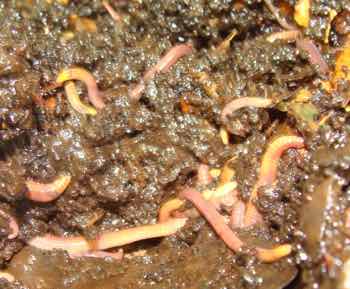
This page was last updated by Bernard Preston on 9th March, 2024.
And now here is an update on our worm farm; firstly we have grown to three tanks, each with two chambers. Finding enough food for them is the limiting-factor. Recently I have taken to collecting scraps from the local supermarket; it is not a pleasant business but the hens and even our dogs have benefited.
It is eleven months since we made a start and the growth has indeed been astronomical; the hens get a 500ml tub of worms once a week. I could give them more but we are trying to expand the farms still to supply the compost-heaps.
When all three worm farms are in full production, the birds will get a tub every day.
If you are commercially minded, you could make a business of breeding and selling worms in your neighborhood; or the wee, for that matter but they multiply so prolifically that I suspect most folk will happily part with an ice cream container of their creepy crawlies for a jar of homemade-jam or a bottle of honey. One of my patients did just that; thanks Jono.
Test the market before investing in a large number of containers; ask your local plumber for rejected concrete laundry basins or bathtubs but in fact they will breed in virtually any structure on the ground. Raising it makes collecting the worm-wee easier; so you can put a bucket underneath.
Your baby worms will grow to maturity in about three months depending on the amount of food you provide. At around a gram apiece, a thousand adults will weigh a pound or two approximately.
Here is an update; four-months after we started with I think about 500 worms; perhaps a bit more or less because we did not count. They were donated by a friend. Well, the farm is simply crawling with the little beasties; and now we are in the rapid growth phase and will have to starting sourcing more food.
They double in number every month; profligate and promiscuous, they mate at every opportunity. So if you started with 1000 wrigglies then, after a year, you would have according to the mathematician in the family about two million.
Number of worms = 1000 x 2^11 = 1000 x 2048
= 2 million
They would weigh a couple tons if you gave them enough food; that is the power of geometric-progression. It is the same as the old Persian story of the king who offered a nave 60 bags of rice; or the option of one grain on the first square of a chessboard, two on the second and four on the third.
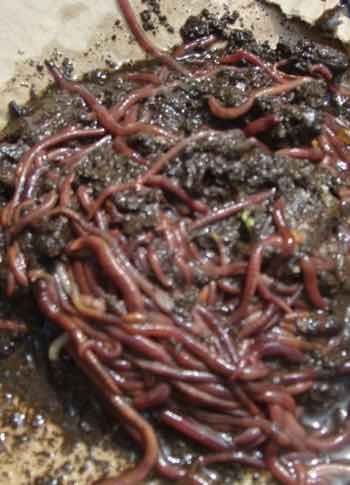
Your organic worm farms consume an incredible amount of food. Very rapidly they will outstrip your kitchen.
Each worm consumes its own weight per day. That means that a 1000 wrigglies will need a kilogram of food.
But after a month there will be 2000 worms; they will demand 2kg of kitchen waste every day.
And after a year those ravenous worms will be demanding a ton or more of food every day; that's a lot of potato peels, rotten apples and mouldy pumpkin.
Starting a worm farm is actually not a big deal but collecting enough food will keep your imagination stretched; we will talk more about that lower down.
What you need is two large containers; those old-fashioned concrete laundry tubs would be perfect but I have located several old fibreglass moulds that are no longer in use at a local business. They are about a metre square by 500 cm deep, divided into two chambers. Each has a waste plug so that you can drain off the liquid manure.
Make sure you leave the plug out or they will drown if too much water accumulates; cut off that pipe stub as short as possible, just long enough so that it protrudes through the plastic ring bolt. You want the whole structure to be as near to the ground.
Since they are living creatures, they need air; so you need a loose fitting lid covered with plastic to keep heavy rain out. It must be dark in there.
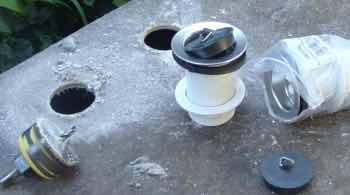
Here is a bit of worm farm DIY. Having found your containers, using a hole-saw, drill an aperture in each half the size of a common waste fitting. Mine were about 50mm at a glance.
There is no need to epoxy them in, nor that the nut is tight. Water is the great enemy; let it leak out; in fact, I've now cut out the grating in the drain-plug.
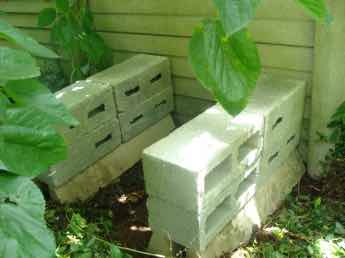
Some concrete blocks, up against this wall, in the shade of a mulberry tree makes the perfect spot for my worm-farm. It needs to be cool and shady; this is south facing, protecting them from the hot northerly summer sun in South Africa.
Make sure those blocks are sloping slightly downwards in the front; you want all the liquid in the worm-farm to drip out.
In fact it turned out to be less than perfect; just over the wall is the apiary and the bees do not like the smell of a farm. Open the lid and the they may go berserk. I had to move the worms.
And three-rows of concrete blocks make the structure too high. Later I lowered it to two; just enough to get a bucket under the pipes; and I am considering only one and digging a small trench to slide the container into. Make it as low as possible; it is hard work digging out the vermi-compost.
"Believe it or not the worm casts are full of biotic material which is, so it is said, very good for nutrition.
Our dogs eat them and I know of a farmer who is feeding worm-casts of a more refined type to his dairy herd to great effect. It is claimed he has a teaspoon daily himself."
Don, the Worm Wizzard
Rainbow worm farm
Rainbow worm-farm is what I have called it; it makes up an important part of our backyard permaculture.
South Africa is known as the rainbow-nation. The worms love the thousands of overripe mulberries that drop out of the tree above them in summer, giving them the purple carotenes they need just as we do.
This is the fibreglass mold nestled up on the blocks that was the introduction to the wonder of worm farms for us. It looks like it was used for making a sitz-bath, or some such.
Make sure you leave the plug out, but cover the outlet with some gauze; actually we do this no longer. Place a bucket under the pipe.
Do not lose that plug; you may need it later.
One of the sadness of the rainbow-nation is that garbage is not collected in many tribal areas; kitchen waste simply gets dumped anywhere and everywhere and a pestilence of rats ruin all local gardening efforts. One of the wonders of worm farms is that they deal with that garbage and because they are sealed the vermin cannot get in.
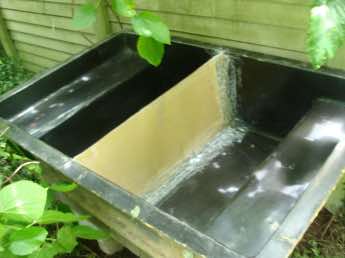
So what do they eat? That's the wonder of worm farms. Frankly just about anything, and in particular anything raw, with the exception of acidic-fruit like citrus and pineapples. There is a question about bread too; you'll have to experiment.
Any dead birds, moles or rats in your ceiling that you've electrocuted are perfect too. They will even eat small amounts of cooked meat, as in a half-eaten hamburger.
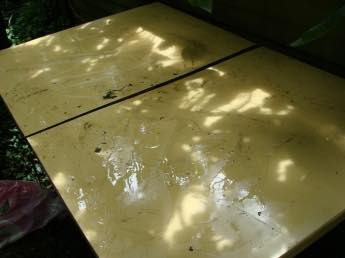
Cover the whole with a layer of compost, large dark leaves like the outer covering of cabbages, or some wet newspaper or cardboard to keep them in the
dark, and a loose fitting lid of some sort, covered with plastic to
keep heavy rain out; they breathe so air must get in.
If those lids keep it sufficiently dark in there, they do not seem to mind if there is no newspaper or cardboard; find them just below the surface. I still like to cover them with old cabbage leaves that they love.
If you have a problem with rat infestation, then it is important that the worm farm covers are reasonably tight fitting, but loose enough to allow the free passage of air.
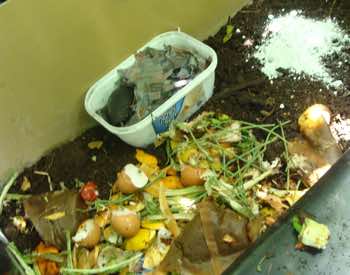
Having the right compost bins gardening makes your life a lot easier.
Start by tossing in half a wheelbarrow of compost which they love. They need large amounts of calcium, so I've thrown in a handful of agricultural lime; in the winter months I use ash from the woodstove instead.
Then I added a bin of organic waste from the kitchen, mixed it all up, sprinkled it using a watering can until water starting dripping out the waste, and released the worms from that icecream container.
Actually, in summer I like to use the husk leaves of our corn, rather than newspaper to cover the whole mess. Newsprint has a lot of junk in it that I do not really want in my garden.
After a compost pile, a worm farm is the next logical step in your own personalised operation end waste.
It is a significant part of getting your garden soil ready for planting.
The wonder of worm farms
The wonder of worm farms is that they are so easy to feed; they will survive if you neglect them, but do remember to keep the plug out, and add a fine spray of water periodically.
Like us humans they need a varied diet for optimal and healthy growth. Every few days add something like this to the menu.
- A shovelful of compost.
- The organic waste from the kitchen.
- Rotten fruit and veg.
- A bucket of cow or horse manure stirred up with water. They thrive on the cardboard
- Up to a quarter, cardboard soaked overnight in water.
- Garden weeds.
- Dead creatures found in the garden.
- 1 TBSP lime or wood ash occasionally.
They particularly like half avocado or gem squash skins for nesting in, a friend tells me.
Absolutely avoid
Absolutely avoid feeding your worms:
- Pineapples
- Citrus
- Chicken litter
- Probably tomatoes
Keep meat and bread to less than 10% of the feed.
You may want to test these out but, as a beginner, I recommend you avoid them; they certainly can spoil the wonder of worm farms according to the gurus. Now I'm less fussy with these, except chicken litter. The worms are very tolerant.
Organic worm farms
Organic worm farms is what it is about; all those raw scraps, peels and rotten fruit and vegetables. They'll turn it all into magnificent compost.
Right now the peaches are fruiting and a lot of stung fruit is falling to the ground; it is a breeding ground for fruitflies that will sting next year's crop. We are collecting them; it is simply another of the wonder of worm farms.
Within a couple months you will have a seething mass of little red worms, growing in numbers exponentially. The wonder of the worm farms is that you can use the liquid that drips out of the bottom for liquid manure, the worms themselves for a high protein chicken food, and any robins you particularly love, and what is left is the vermicompost; it goes into your compost pile, and I suppose could go straight into the garden.
It is important that the process remain aerobic; adequate oxygen must get down to the depths, because anaerobic activity will stink. Some folk use cardboard to keep it aerated but I'm reluctant to use anything with chemicals; so we use coarse weeds and garden material; do not make it too deep.
As you can probably tell, I was a novice when I first wrote this some five years ago; and we are still learning, but a couple hundred worms has exploded into uncountable hundreds of thousands, like the sand on the seashore.
Worm farm instructions
Worm farm instructions continue as follows. It is time to colonize the other half of your tub. As before, place gauze over the plug hole, leave it open, and add half a wheelbarrow of raw compost from the garden and some lime; then water the whole until it drips out of the waste.
Actually I no longer use the gauze; it contributed to making the bottom too wet; we lose very few worms into the bucket below.
Of course you can make this bigger or smaller according to your desire, and the amount of food available and the size of your garden.
Leave your cardboard, cabbage leaves or old carpet in place as they do not like the light.
Using a garden fork scoop out the seething mass of worms, adding them to the second tub. Within a year, when you have hundreds of thousands, you will reserve some for your compost heap, remembering to cover them; the light will kill them.
And of course, if you have chickens, the wonder of worm farms will in a moment reveal a gourmet meal. You are about to witness a scene of total poultry delight; like gannets they plunge into the sea of vermicompost. It is something akin to having a tender fillet steak and large summer salad, with avocado and hummus placed in front of you.
What is left in the tub is the most perfect vermicompost for your garden.
If you want to go on to a million, then immediately populate the original tub again with some of the worms.
Otherwise, just repeat this process every month or so, and feed your surplus worms to the birds in your garden, or hide them in the compost heap.
Empty the wee-bucket as soon it is above half full; a few baby worms may slip through and drown in their own urine.
A little tip of some import; when you remove that plug, do not take your eyes off of it. If it is black it very easily gets lost in the muck. Mine has gone. To be honest I have not replaced it and no longer use one; air in worm farms is more important.
Keep the worm farm covered with a layer of compost or well-rotted manure; they love it, and it prevents the whole from stinking in the summer. Empty the wee regularly; it does smell.
Compost piles
Compost piles and worm farms go hand in hand; humus thrives with the wonder of an addition of worms, and adding a shovelful of compost to the top of the drum keeps the unpleasant smell to a minimum and the worms love it.
Starting a compost pile is vital in every organic garden; it is the only way for your plants to get a healthy diet, and of course will have an add on effect to your own health.
Update
One starts the wonder of worm farms with advice from a book or friend, and then continues to update their technique. I now forego the putting in of a plug and slowly filling the whole with water; it is too tiresome. Most of the worms are in the upper half of the tub; that goes into the second chamber. The lower half just goes straight to the compost heap to which the hens are admitted for a period.
The longer you leave the hens there, the fewer the worms that will survive to inhabit your compost pile; better eggs but the humus will take longer to break down.
Finding worm farm food
Finding enough food for the wonder of worm farms is a mission if you really want to grow the numbers. Remember, within a year you're looking at a ton of food per day if you do not release the worms into the garden, and feed them to the birds.
- Ask your local greengrocer or supermarket if they would fill a bin of old fruit and vegetables every day.
- Place a couple bins at the local primary school for left over lunch. Ask them to remove any inorganic wrappings and place in another bin right next to the one for worm farm food. The worms will love any half eaten sandwiches. In return give them a couple litres of liquid manure for the school garden every now and then.
- Leave a bin at your front gate and ask the neighbours for their organic waste.
- And of course all the waste from your own garden.
If you are a serious greenie, invite your children's class to come and see what's needed to preserve the planet; they'll be fascinated by your worm farm and compost heap and, if you have one, chicken tractor. This is far too important to leave to fickle politicians and Cop 21; it is our responsibility, and vital to hand on to the next generation. After all they will have to live on the polluted planet we have left behind.
There are more thoughts on this subject of finding enough food at my attempt to answer from another angle what is a worm farm?
Bulking agent
Cardboard in worm farms makes a useful bulking agent, increasing the porosity of the feed and maintaining the water content.
Worm wee
The vermi-leachate is a wonder above the other wonders from your worm farm. Place a bucket under the outlet and decant it regularly onto your favourite plants; it smells a bit so empty it frequently onto the garden if the worm farm is near your home.
I suggest twice a day in the early stages as, with the best will in the world, some of the baby worms will get through your sieve and try to commit suicide in their own leachate. When you have a couple million, you'll be less concerned.
They are amazingly resilient though and even though under water for several hours, they will revive. Just watch the bucket; if no worms get through then you can obviously leave it longer.
For many the worm wee is the major wonder of your worm farms; it saves you purchasing foliar feeds. Does it really make a difference? Follow our rainbow worm farm experiments using corn as the medium in this instance; I don't actually know the answer, so I'm as intrigued as you are!
Then all the trees on our citrus fruit list and the avocados regularly get a bucket of diluted worm wee; even our cymbidiums are flourishing.
Don't use worm wee though on young seedlings unless it's thoroughly diluted; at least ten times. It will burn them.
My choice method is to pour the worm wee straight on your mature-plants either just before or after a rain, or water it in thoroughly; it saves a lot of time.
Doggy-poo worm farm
Doggy-poo worm farm is the perfect way to dispose of a problem all pet lovers face. Cat litter and guinea pig wood shavings will go equally well.
Don't use this worm-wee for your lettuces, though, for obvious reasons. It only goes on your flowers and fruit trees; well, perhaps on the corn is okay.
Doggy-poo worm farms don't smell much because you cover it with a layer of compost, as well as the usual waste from the kitchen; but the worm wee needs to be disposed of daily; it does smell if left for too long.
As with most things to do with permaculture there is some extra work to be done with the wonder of worm-farms.
Selling worms
Selling worms could be a successful little business.
So could selling small basic worm-farms also become a little business? I don't see why not.
Chicken tractor design
Chicken tractor design goes hand in hand with the wonder of worm farms.
Your kitchen and garden refuse gets turned into wondrous food for your chooks. They in turn root out the weeds, cutworms and snails and other predators that destroy your seedlings, and give you wonderful healthy eggs which have not had artificial colouring added to the food to deceive you into thinking that they are from free range chickens.
Once the wonder of worm farms is in full production, you can easily spare a handful of creepy crawlies every day to add protein to the chickens' diet.
The chicken manure adds valuable nitrogen to the soil, obviating the need for inorganic fertiliser, but don't add it to the worm farm.
Just look at the hens tucking into the worms; it's Christmas! Chickens in the garden are a wonderful addition, but planning and aforethought, as with all new projects is needed. They will scratch out your carefully planted seedlings and simply devour the kale; they need the lutein for their sharp eyesight; so do we.
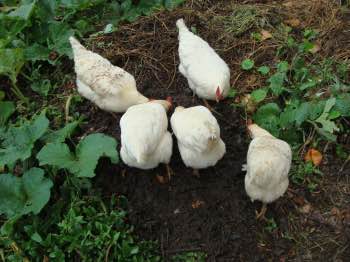
Birds and bees
Birds and bees may not mix, especially if you are toying with the wonder of worm farms.
Fellow Beekeepers,
I am sure you all know that a wheelbarrow of newly mown grass is a red rag to a bee. Not many of you also have a worm farm, I expect.
Opening a worm farm, if anything, is even more of a signal to bees to go absolutely berserk; perhaps it’s the hot dry weather, too. It is strange because they produce little odour to us, but to the bees it is maddening.
Research scientist Mike Allsopp also points out that if the lesser hive beetle gets into your worm farm, they will consume all the worms.
In short, if you plan to indulge in the wonder of worm farms which you are likely to do if you are a greenie, then keep it well away from the apiary.
Smoke did nothing to curtail the madness, but a fine spray from the hosepipe did wonders. They stung the hell out of our hens for the first time.
What’s the virtue of a worm farm? They will consume all the kitchen left overs, produce a liquid fertiliser that makes a magnificent feed for your plants and, if you have hens, provide a high protein feed for the birds. The thrushes love them too. In your compost heap they speed up the break down of vegetable matter.
Your fellow lover of birds and bees,
Bernard Preston
Weeds
We have some pesky weeds with bulbs called oxalis that can't go in the compost heap; feed them to the wonder of worm farms too, or to the chickens.
The wonder of worm farms is that they solve a lot of problems in the garden; disposing of doggy poo and cat and hamster litter, and fruit and veggies that have been stung. You don't want them in the compost heap where they'll breed for next season.
We have been resolutely collecting and dumping all the stung plums into our worm farm this year; I'm intrigued to see if it makes a difference. We should also let the hens into the orchard and see if they don't sort out the fruit fly like they have the plague of Mexican bean beetle larvae that more or less put an end to our growing green beans.
Wizzard worms
Wizzard worms is an amazing small enterprise totally committed to seeing the spread of the worm farm culture.
It's worth a look at Wizzard Worms wherever you live, but particularly if you live in KZN, South Africa, and are interested in getting started.
They have perfected the wonder of worm farms.
Choice foods
If you're into growing nutritious choice foods, then give a thought to the wonder of worm farms; not only will they consume all your kitchen-waste, but greatly enhance the plants in your garden.
Toss the excess worms into your compost-heaps.
The wonder of worm farms
The wonder of worm farms is admittedly a dirty business but, my goodness the benefits for the organic garden are simply enormous; and a large part of it lies at the heart of the philosophy of operation end waste.
On the other hand there are other tensions like whether Fetida should be included on the list of invasive alien species.
One other not to small advantage of the wonder of worm farms is that by using vermicompost you won't have to worry about the definition of cutworm, as you do with compost heaps; that's where they love to breed, and it's an ongoing problem for every gardener.
- Go from the wonder of worm farms to what's potting in the garden.
- Making a compost pile
- Worm farms and the black plague
Bernard Preston
Bernard Preston writes these blogs like the wonder of worm farms for his good pleasure. It's not entirely altruistic! It is also where I sell my books; if you have enjoyed this site then you can help me sell a million copies of A Family Affair.
Only a dollar each for the trilogy; now that will not break the bank; small beer in thanks for the information contained in the wonder of worm farms.
Here's chapter one: Jan Jansen
Newsletter
Our newsletter is entitled "create a cyan zone" at your home, preserving both yourself and Mother Earth for future generations; and the family too, of course. We promise not to spam you with daily emails promoting various products. You may get an occasional nudge to buy one of my books.
Here are the back issues.
- Lifestyle and ideal body weight
- What are ultra-processed foods?
- Investing in long-term health
- Diseases from plastic exposure
- Intensive lifestyle management for obesity has limited value
- A world largely devoid of Parkinson's Disease
- The impact of friendly bacteria in the tum on the prevention of cancer
- There's a hole in the bucket
- Everyone is talking about weight loss drugs
- Pull the sweet tooth
- If you suffer from heartburn plant a susu
- Refined maize meal and stunting
- Should agriculture and industry get priority for water and electricity?
- Nature is calling
- Mill your own flour
- Bake your own sourdough bread
- Microplastics from our water
- Alternative types of water storage
- Wear your clothes out
- Comfort foods
- Create a bee-friendly environment
- Go to bed slightly hungry
- Keep bees
- Blue zone folk are religious
- Reduce plastic waste
- Family is important
- What can go in compost?
- Grow broad beans for longevity
- Harvest and store sunshine
- Blue zone exercise
- Harvest and store your rainwater
- Create a cyan zone at your home
Have you read my latest trilogy? Only $1.14 each. Hold onto your hat. Find A Family Affair by Bernard Preston at Amazon.
Did you find this page interesting? How about forwarding it to a friendly book or food junkie? Better still, a social media tick would help.
- Bernard Preston homepage
- Worm farms
Address:
56 Groenekloof Rd,
Hilton, KZN
South Africa
Website:
https://www.bernard-preston.com